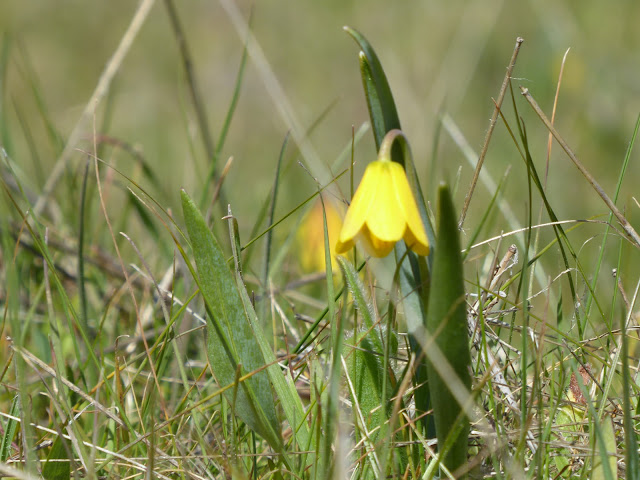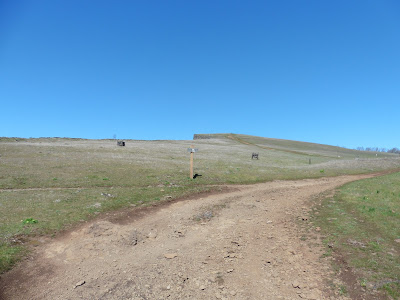Coyote Wall Hike
At the East End of the Columbia Gorge, on the Washington side, is a big basalt cliff rock formation that is called Coyote Wall and/or Syncline. There is a free (and large for its kind) parking lot at a Federal Park service trail head. This is an area where the intentional flooding of the Columbia (by the dam at Bonneville) forced the highway and the train line to be routed on stone roadways that seems to have forced the creation of a bunch of little lakes and ponds. The Coyote Wall trailhead (and part of the trail) are old road that used to go along the cliff further up from the current road.
You get incredible views as soon as you get out of your car with the towering and sheer basalt cliff rising up directly ahead of you, where the old road winds through a rock fall and then around to the trail start.

 |
| Looking up from the old highway |
 |
| Looking back toward the parking lot. |
The cliff and the area is called Syncline on the maps but this is not geologically accurate. A syncline is a rock formation where layers of rock have been folded or buckled. The Syncline is the part of the fold where the newest layers (usually the upper ones) are folded "down" (concave). In the case we have here, the rock formation is running North-South and the actual syncline part is under the Columbia river. On both sides of the river we have the opposite of a syncline, called an anticline. The Coyote wall is also named (at least by geologists) the Bingen Anticline. (Bingen is a little town just west of the cliffs). More data here.
The hike starts off by walking down the (now blocked off) old state road. There are really good views of the cliff all along here, but don't forget to look over your right shoulder, you'll get a glimpse of Mt. Hood peeking over the South side of the Gorge. In the spring there are lots of little mini-waterfalls as seasonal creeks come spurting off the rock facing and down toward the road. Along the road is a lot of yellow desert parsley. It has a very strong lovely smell even this early in the season.
Out in the lava lands of the west, it is very hard to dig a hole to properly plant a fencepost. So the ranchers often use rough plank "boxes" filled with rocks (to keep them in place). There are a couple up ahead that mark the start of an old ranch road called "Old Ranch Road". This road is the original trail most of the way up the hill and we will be criss-crossing it for the rest of the day.
 |
| Start of "Old Ranch Road" |
We are going to hike up the hill the long way through a winding valley, and then come back down the more abrupt path over close to the wall. Because that is easier. The upward trail is called Little Maui Creek Trail. This early in the spring it is a beautiful green meadow with short grasses and the starts of little wild flowers at every turn. The big trees (Oak and Big-Leaf Maple) have some small buds but no leaves yet. Best of all, the Poison Oak is still dormant, though I can see where it is going to come screaming out from beneath the big trees when the summer sun is high overhead.
 |
| There are these little hard to read signs. if go up to them you can read them. They say "Keep off of this Area" |
 |
| Little Maui Creek |
 |
| That is the Columbia, down there (and Little Maui Creek). |
There is a little creek (called little Maui Creek) that wanders down the hill through this little rocky valley. It adds a certain amount of magic to the scenery. Funny, the pictures I show here look pretty much exactly like what you see there. Such a pretty sight. My partner was having a lot of fun finding and photographing the many small wild flowers that we were finding on the way. I predict many more spring wild flower hikes in our future. Below is my attempt to take her wonderful pictures and put some sort of name to each flower. (if you know the ones that I missed, please leave me a note)
 |
| Pungent Desert Parsley |
 |
| Grass Widow |
 |
| Columbia Desert Parsley |

 |
| Yellow Bell |
This part of the trail keeps winding up. After a mile or so, you come to a little ridge and then hike back across toward the wall. You meet up with the old Ranch road again and now you can see the edge of the cliff and your hiking trail going up and up to the top of the hill. This area is a rocky profile and a natural constriction to the Columbia river. During the massive Missoula floods at the end of the last ice age, the huge waters that came streaming down from Montana were constricted here and backed up right on this very rock face on which we are hiking. Right about where the ridge is was the line of high water, some 950 feet above the current Columbia river waters. That certainly explains where there is very little top soil on the first part of this hike.
As we are hiking, there are a lot of mountain bikers either riding or pushing their bikes up the trails behind us. It is a popular spot to trek up to the top of the ridge and then come blasting down either on the long loping trails (like the one we are on) or down the step rocky path over next to the wall. We are going to go over there and see that on our way down too.
But right now, we get to hike over to the wall (we can see the drop off) and see that is there. Wow there is a view for you. Shear basalt wall down a couple of hundred feet to a steep rocky scree and then a couple hundred feet of that to a oak and brown forest floor. Coyote wall extends up from where we are a good mile and another 500 feet of elevation gain.
We continue hiking upward. This are is criss crossed with bike trails and old jeep tracks. You know, bike trails are really hard to hike on. These things, in some places, are 1 or 2 feet deep and only about a foot wide at the top and maybe 6 inches wide at the bottom. You may be able to drive a bicycle through it, but it is very hard to get your feet to land in the groves without tripping you or just making your feet hurt. We try and walk on the side of the things or up off the trail.
 |
| Looking up the hill |
 |
| Bicycle Tracks |
After struggling up the hill, staying close enough to the cliff that we can wander over for a view every once in a while, we hiked up to where some ponderosa pines and other trees are growing. We are not at the top, but we are at a national geological survey marker. Seems like a good place to declare
"half way to the car" and stop for lunch. This is my little joke. Something about the way I dress or the pack I carry or something makes people think that I know where I am going. Not only that, but but it makes them think that I know where they are going. They often stop me and ask me how much farther it is. That is the question "How much farther is it?" My smart aleck response is usually "Well, I don't know where you are going, but when you stop and turn around for your car, you are half-way." It may be a little smart aleck, but I also think it is wise to remind people that they need to save themselves enough water, sunlight, and personal energy to make it back to their vehicle. I know that is something that concerns me. For instance, on this trip, I calculated the amount of time it would take to hike back down to the car, drive back to Portland, and still give me 30 minutes to take a hot tub before we had to meet our friends for dinner. That calculation said we were at "the top" Right About..... NOW.
Nice view from up there.
 |
| Lunch |
 |
| This is 12 mile island. The only privately owned island on the Columbia |
So, this time of year, Mount Hood rises in the South. It is about a Half Hood in March and I stopped every little bit to take pictures as it was rising up over the rim of the Gorge. Must come back in the fall when the Full Hood should be showing by mid day.
 |
| Today's date is April 1, 2018 |
Just about nobody gets that joke. I have to work on my material.
On the way back down, we took the (trail name forgotten) trail that goes right down the side of Coyotee wall, usually within 30 feet of the drop off. That was pretty nice, and we took our time and did some more sight seeing. Got passed by a few bikers on the way down, There were very polite, everyone was having a good day. Hey, I can see our car!!
 |
| Please buy my book, "The art of the selfie" |
I rate this hike as a great hike for Spring wild flowers. Not sure I would like it as much for the Summer Heat and Poison Oak.






















